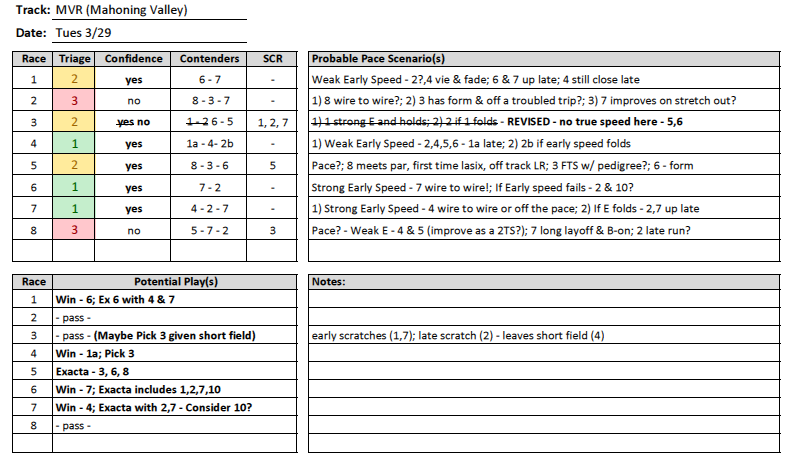
Billy Currington
Billy Currington may have recorded that song, but I am also pretty good at drinkin’ beer. I made a rare on-track appearance at Parx a few weeks back and, by having done my homework the night before, I had some downtime between plays and rather than try to force plays, I enjoyed a few refreshing beverages and just watched non-bettable races.
How many folks do you see at the track that are handicapping the upcoming race with five minutes until post time, leading to rash and possibly uninformed decisions followed by torn-up tickets thrown all over the ground?
How do you avoid this insanity? The key is to do your homework the night before. Start by triaging the race card (see my previous article Rapid Race Triage Assessment for more details) to focus your handicapping on the races that appear to offer the best opportunity and to keep the number of tracks you have in play manageable. Once you have handicapped, you will know where you feel the best and you can establish a level of confidence in the race.
This is when I map out my early potential plays that will be reevaluated once the scratches and changes have been announced on race day (see my article Reevaluating the Pace Scenario After Scratches: Part 1).
Normally I fill out a sheet for each track when I try to analyze an entire race card. For your benefit, I have taken my sheet for Mahoning Valley from March 29, 2016 and typed the information in rather than subject you to trying to decipher my penmanship and the shorthand abbreviations I use. I have shown the impacts of the scratches in the third race which was reevaluated before the day’s racing started.
The components I have on my daily sheet:
- Triage – This is the triage assignment from my initial size-up of the race card before handicapping. I often find that the less urgent races (noted as 3’s or 4’s) are usually also my least confident races.
- Confidence – After handicapping and analyzing the pace scenarios this is a gauge of how confident I am that I have identified either the pace scenario and/or the contenders in that race.
- Contenders – Typically there will be more than one in this column. Based on the likely pace scenario(s), angle plays, or pedigree, I list the horses that I feel have a legitimate chance in this race.
- SCR – I always note the scratches on my top sheet since this leads me to reevaluate the race.
- Probable Pace Scenario(s) – Here I describe how I think the race will set up with some races having more than one possible scenario. In races where the pace is difficult to decipher, I will typically list reasons for the contenders that may include pedigree information, notes on form, or an angle play (similar to angles described in my articles Back Too Soon and Love is Lovelier the Second Time Around).
- Potential Plays – Here I note the strongest plays I think I have. If I am thinking about playing exactas or trifectas I will also note horses that I would consider for second or third place that may not necessarily be contenders to win. These horses may include frontrunners that I think will fail, but may have enough pace left to make it close late. These plays are always ultimately decided on the real time odds and will pays for exotic wagers. Sometimes the odds do not warrant the risk.

I will briefly run through the thought process on each of the above races:
Race 1 – My initial triage had this race as a moderate priority. I was able to identify the most probable pace scenario with a high level of confidence. In this case I liked the 6 to win and considered playing the exacta here with a second late pace horse (7) and an early speed horse that I felt would quit, but might still be close at the wire (4).
Race 2 – Initially triaged as a low priority race since the race had several variables in play. Given his fractions, the 8 appeared to be likely to get to the lead by the second call, if not sooner, but had not displayed great form. The 3 showed some form and was coming off of a troubled trip, but comparable races didn’t give this one much of an edge. The 7 was a consideration since he was likely to improve while stretching out. Given all the variables and multiple pace scenarios that were not clear, this race was not worth playing.
Race 3 – Originally I saw some promise in this race and tagged it as a medium priority and was able to identify two horses with two fairly likely pace scenarios. Early scratches of the 1 and 7 set this race up for the 2 who was ultimately scratched at the gate resulting in a four horse field. While I did not see any value in play this race, the potential here lied in connecting it with the next two races that I felt pretty good about in a Pick 3.
Race 4 – This race was tagged as a high priority since there was a lot of weak early speed and the 1A had some late pace and was dropping out of restricted stakes company. Despite the early speed horses I noted not getting to the lead early, the other half of the coupled entry did get out to an early lead that set up the pace for her stablemate. In this case, I was targeting the win play since the underneath horses in the exotics seemed fairly open.
Race 5 – This maiden race was a medium priority since in my initial triage three horses jumped off the past performances at me. While the pace was in question, I still liked the same three horses after doing my handicapping and would figure to use them in some way in an exacta.
Race 6 – The initial triage assigned this race a high priority given the strong early speed horse I found in my initial scan. When playing smaller circuits with more volatile fractional times between race dates, I often think of hedging my bet. In this case I selected the two strongest late pace horses I could find and would consider using them in an exacta while playing this strong early speed horse to win.
Race 7 – Another strong early speed horse was identified in my initial triage giving this race a high priority designation. Based on the rest of the field, I figured this horse could duel or take the race all the way on the lead. Applying the same logic as I did in the previous race, I looked to see what horses could be running late to round out my exotics.
Race 8 – The last race of the day garnered a low priority rating upon my initial assessment. There were too many variables amongst this field to definitively arrive at the most likely pace scenarios. This race was a pass.
There is no need to play every race, especially if you have little confidence or see no value in playing that race. By preplanning your potential wagers, you are taking the adrenaline-inspired plays out of the equation.
Naturally, the urge to have some action is much harder to resist when you are on track with nothing else to do than when you are logging on from your home computer to play a race or two you really like.
So, when I am on track with some down time between betting opportunities and have a responsible driver to get me home safe, I remind myself just how good I am at drinkin’ beer!




